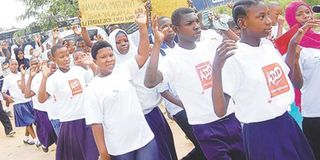Is half of Tanzania’s deaf population illiterate?

Peoples with problems of deafness in Dar es Salaam and Coast regions demonstrate in Bwawani grounds in Maili moja Kibaha to commemorate the Word Deaf Day
What you need to know:
This survey found that 12 out of every 1,000 Tanzanians suffer from a hearing impairment, or a total of 536,088 in 2014.
Tanzania’s media and government authorities are reporting that as much as 55 per cent of the country’s deaf population is illiterate, locked in poverty, with few prospects for secondary school or university education.
Speaking at graduation day for Dodoma’s School for the Deaf, headmaster Kennedy Maingu told parents and the media that there simply aren’t enough specialist secondary schools for the deaf in Tanzania and that pupils therefore struggle to progress beyond primary school.
The limited number of special education schools, Mr Maingu says, is compounded by an acute shortage of specialist teachers because there is only one teaching college for those seeking to learn Tanzanian Sign Language.
Mr Maingu’s warning comes in the wake of reports from the National Bureau of Statistics (NBS) that estimates that as many as 55 per cent of the country’s deaf population are functionally illiterate.
So, the question is, how many deaf Tanzanians can read and write in any language?
PesaCheck has researched the issue, and finds the claim that half of Tanzania’s population is illiterate to be TRUE for the following reasons: While research into deaf education in Tanzania is limited, the NBS conducted the Integrated Labour Force Survey in 2014 that looked at, among other things, the number of persons with disabilities in the country. This survey found that 12 out of every 1,000 Tanzanians suffer from a hearing impairment, or a total of 536,088 in 2014.
Of these persons with hearing disabilities, the ILFS survey showed that 241,453 were literate in English, Swahili or any other languages, and 294,635 were illiterate, meaning that 55% of Tanzania’s deaf population can neither read nor write.
The biggest contributor to this high level of illiteracy is the difficulty in accessing dedicated public schools for the hearing-impaired in Tanzania. A study on access to education for the deaf states that in 2009, there were approximately 91 000 deaf students in Tanzania, but there were only 7 schools capable of providing them with a proper education.
According to the report, all these schools were private at the time of the study, meaning that the government played no part in their operation. Private schools are prohibitively expensive in Tanzania, making them inaccessible to poor families, especially given how much it would cost to acquire hearing aids and other such assistive devices.
The study did show that there are about 14 deaf units that attached to mainstream schools catering to about 500 deaf or hard of hearing children. Many of these schools offering boarding facilities as well.
A 2017 report by Human Rights Watch shows that Tanzania has 27 secondary schools in for children with disabilities such as albinism, visual impairment and hearing impairments as well.
These 27 secondary schools are meant to cater to 87,378 hearing impaired youth, making access to education for the hearing-impaired especially difficult. Furthermore, those beyond school-going age are left without the means to acquire basic literacy and numeracy skills.
The lack of specialized education facilities for the hearing-impaired has contributed to the high levels of illiteracy in the community, and the various statistics published by the government of Tanzania confirm that the assertion that half of the country’s deaf population is illiterate is TRUE.
Belinda Japhet is a communications consultant and writer.




